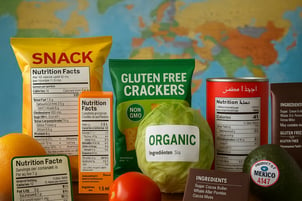A Guide to Cosmetics Regulations in Africa
Bringing a cosmetic product to market today is a regulatory challenge today, more than a creative or scientific process. Each country enforces its own set of rules around formulation, labeling, testing, and distribution. As the industry expands globally, staying compliant across borders, especially with evolving international cosmetic regulation, has become a necessary part of operations.
Understanding cosmetic regulations is not only about meeting legal obligations. It is also about gaining consumer trust, avoiding delays in launching cycles, and ensuring products meet the standards expected in each region. For companies looking to expand internationally, regulatory clarity and strong international cosmetic compliance is a strategic requirement.
This guide provides a foundational overview of regulatory authorities across key global markets. It outlines the primary compliance bodies governing cosmetic products in each region. Understanding these authorities is essential for aligning product development and market entry strategies.
Why Cosmetic Regulations Exist and Why Do They Matter
Cosmetic regulations are designed to ensure that products are safe for consumers and accurately represented in the market. These laws cover ingredient safety, product testing, manufacturing practices, packaging information, and marketing claims. They create a baseline for quality and safety that every brand is expected to follow.
They also help protect against misleading claims or unsafe formulations. If a product causes harm, contains banned substances, or makes unverified claims, the brand can face product recalls, fines, legal action, or even removal from retail shelves. In a highly competitive industry, these outcomes can damage both market access and consumer confidence.
What makes compliance more important today is the rapid global movement of beauty products and increasingly strict international cosmetic regulation standards. A product formulated in South Korea may be repackaged for consumers in Paris. A serum sold in California may be manufactured in India. In each case, different regulations apply, and companies are responsible for aligning with the standards of every market they enter.
Regulations ensure that this cross-border activity happens in a controlled, predictable way. For cosmetic brands, understanding these rules is not just necessary to avoid risks, it is essential for operating efficiently across the world.
The Must-Know Cosmetic Regulatory Authorities
Cosmetic regulations vary by country, and of course each region has its own governing bodies responsible for defining and enforcing compliance standards. Below is a list of the primary regulatory authorities one should be aware of, organized by region.
| Region | Country/Group | Regulatory Body / Regulation |
| USA | United States | FDA – Food and Drug Administration |
| Europe | European Union | EU Cosmetics Regulation (EC No. 1223/2009) |
| Asia | ASEAN | ASEAN Cosmetic Directive – Regulatory framework adopted by ASEAN member countries |
| India | CDSCO – Central Drugs Standard Control Organization | |
| China | CSAR – Cosmetic Supervision and Administration Regulation NMPA – National Medical Products Administration |
|
| Japan | PMDA – Pharmaceuticals and Medical Devices Agency MHLW – Ministry of Health, Labour and Welfare JCIA – Japan Cosmetic Industry Association |
|
| South Korea | MFDS – Ministry of Food and Drug Safety | |
| Indonesia | BPOM – National Agency of Drug and Food Control | |
| Taiwan | TFDA – Taiwan Food and Drug Administration CHSA – Cosmetic Hygiene and Safety Act |
|
| Australia | Australia | TGA – Therapeutic Goods Administration AICIS – Australian Industrial Chemicals Introduction Scheme ACCC – Australian Competition and Consumer Commission |
| Middle East | United Arab Emirates, The Kingdom of Bahrain, The Kingdom of Saudi Arabia, The Sultanate of Oman etc |
GSO – GCC Standardization Organization |
| Africa | Nigeria | NAFDAC – National Agency for Food and Drug Administration and Control |
| South Africa | SAHPRA – South African Health Products Regulatory Authority |
Staying Up-to-Date with Regulations
Cosmetic regulations are continuously evolving. Authorities regularly update ingredient lists, labeling requirements, safety protocols, and import procedures, often with very little notice. What was acceptable six months ago might now be restricted or require additional documentation.
To illustrate: Colchicine, used to treat gout, was available before the 1938 regulations, but in 2009 the FDA approved a brand-name product (Colcrys) and ordered other unapproved colchicine products to stop being made. This demonstrates how regulatory perspectives shift even on long-used ingredients.
For companies operating across multiple markets, staying current is critical. Missing an update can lead to delayed launches, shipment holds, or failed audits. In the age of global product movement, international cosmetic compliance must be continuous, not occasional.
Modern cosmetic businesses need systems that alert teams to regulatory changes in real time, map those changes to products in the pipeline, and flag actions that need attention — whether it’s updating a label, reformulating, or preparing new documentation. Compliance today is not reactive, but proactive.
How a Cloud-Native PLM Software Can Help
Managing cosmetic compliance across markets isn't just a regulatory challenge, it is an operational one. As brands expand globally, the need to coordinate product data, documentation, and updates across regions becomes increasingly complicated.
Cloud-native product lifecycle management (PLM) software is helping cosmetic companies streamline this process. By centralizing product information in a single, secure system, teams can:
-
Maintain and track country-specific product variants based on local regulations
-
Store, organize, and retrieve compliance-related documentation with version control
-
Push formulation or label changes across multiple markets without duplicating manual work
-
Collaborate across R&D, Regulatory, Legal, and Marketing functions with shared, real-time access to product data
Instead of chasing updates across spreadsheets or emails, teams are building workflows that are structured, traceable, and audit-ready. And the best part? All of this happens by one integrated, cloud-native platform making international cosmetic regulation management far simpler and faster.
Final Thoughts
Cosmetic regulations are not static and neither is the market. With trends, ingredients, and consumer expectations constantly shifting, regulatory compliance has become an ongoing part of doing business, not just a launch checkpoint.
Building a brand that can scale across geographies means building systems that are flexible, informed, and built to evolve. Understanding global compliance frameworks is only the beginning. The real advantage lies in how quickly and accurately your organization can respond when those frameworks shift.
Operational readiness, cross-functional coordination, and digital infrastructure are the groundwork for staying competitive in a highly regulated, high-growth industry especially under today’s heightened international cosmetic regulation and international cosmetic compliance standards.
Tags:
Jul 1, 2025 3:13:17 PM








